通信与信息工程专业英语教程
- 格式:docx
- 大小:24.65 KB
- 文档页数:5
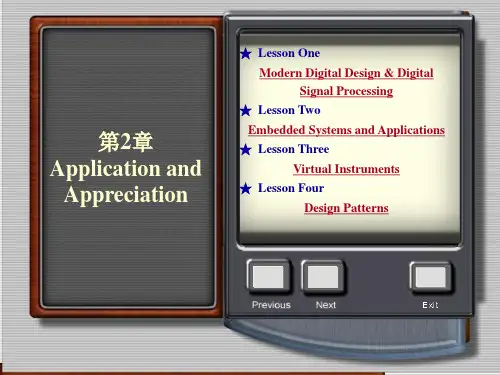
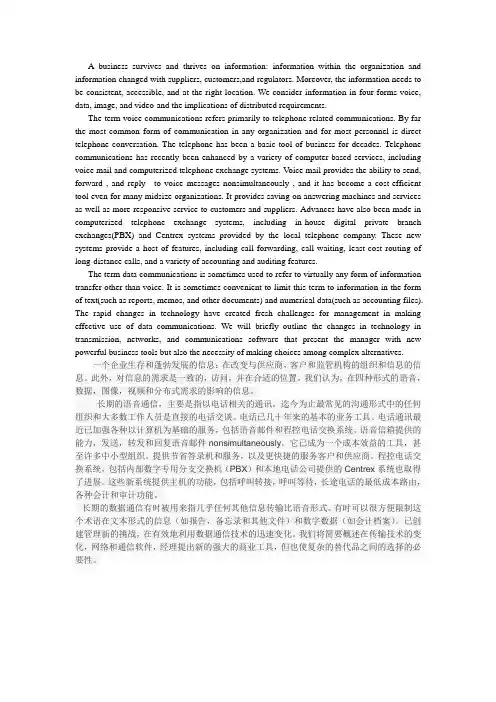
A business survives and thrives on information: information within the organization and information changed with suppliers, customers,and regulators. Moreover, the information needs to be consistent, accessible, and at the right location. We consider information in four forms-voice, data, image, and video-and the implications of distributed requirements.The term voice communications refers primarily to telephone related communications. By far the most common form of communication in any organization and for most personnel is direct telephone conversation. The telephone has been a basic tool of business for decades. Telephone communications has recently been enhanced by a variety of computer-based services, including voice mail and computerized telephone exchange systems. V oice mail provides the ability to send, forward , and reply to voice messages nonsimultaneously , and it has become a cost-efficient tool even for many midsize organizations. It provides saving on answering machines and services as well as more responsive service to customers and suppliers. Advances have also been made in computerized telephone exchange systems, including in-house digital private branch exchanges(PBX) and Centrex systems provided by the local telephone company. These new systems provide a host of features, including call forwarding, call waiting, least-cost routing of long-distance calls, and a variety of accounting and auditing features.The term data communications is sometimes used to refer to virtually any form of information transfer other than voice. It is sometimes convenient to limit this term to information in the form of text(such as reports, memos, and other documents) and numerical data(such as accounting files). The rapid changes in technology have created fresh challenges for management in making effective use of data communications. We will briefly outline the changes in technology in transmission, networks, and communications software that present the manager with new powerful business tools but also the necessity of making choices among complex alternatives.一个企业生存和蓬勃发展的信息:在改变与供应商,客户和监管机构的组织和信息的信息。

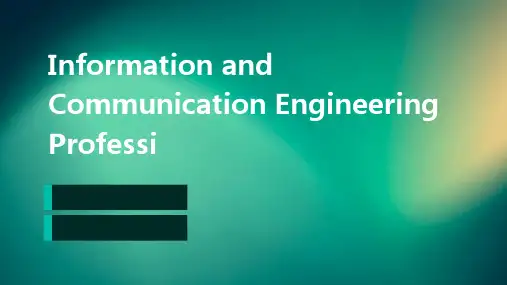
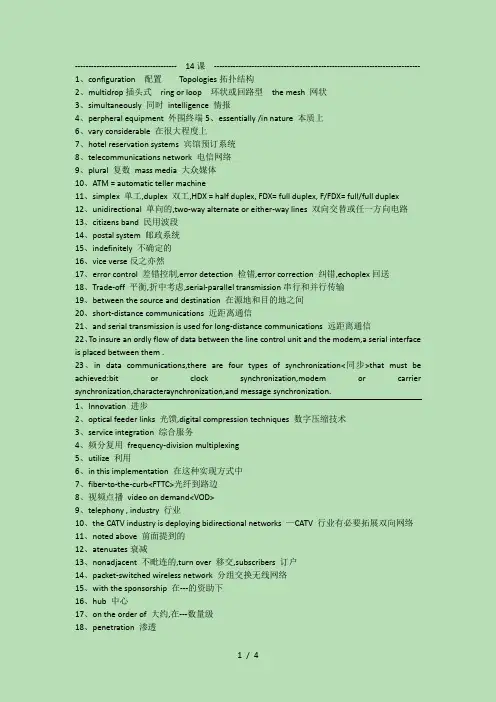
-------------------------------------- 14课-----------------------------------------------------------------------------1、configuration 配置Topologies拓扑结构2、multidrop插头式ring or loop 环状或回路型the mesh 网状3、simultaneously 同时intelligence 情报4、perpheral equipment 外围终端5、essentially /in nature 本质上6、vary considerable 在很大程度上7、hotel reservation systems 宾馆预订系统8、telecommunications network 电信网络9、plural 复数mass media 大众媒体10、ATM = automatic teller machine11、simplex 单工,duplex 双工,HDX = half duplex, FDX= full duplex, F/FDX= full/full duplex12、unidirectional 单向的,two-way alternate or either-way lines 双向交替或任一方向电路13、citizens band 民用波段14、postal system 邮政系统15、indefinitely 不确定的16、vice verse反之亦然17、error control 差错控制,error detection 检错,error correction 纠错,echoplex回送18、Trade-off 平衡,折中考虑,serial-parallel transmission串行和并行传输19、between the source and destination 在源地和目的地之间20、short-distance communications 近距离通信21、and serial transmission is used for long-distance communications 远距离通信22、To insure an ordly flow of data between the line control unit and the modem,a serial interface is placed between them .23、in data communications,there are four types of synchronization<同步>that must be achieved:bit or clock synchronization,modem or carrier synchronization,characteraynchronization,and message synchronization.1、Innovation 进步2、optical feeder links 光馈,digital compression techniques 数字压缩技术3、service integration 综合服务4、频分复用frequency-division multiplexing5、utilize 利用6、in this implementation 在这种实现方式中7、fiber-to-the-curb<FTTC>光纤到路边8、视频点播video on demand<VOD>9、telephony , industry 行业10、the CATV industry is deploying bidirectional networks —CATV 行业有必要拓展双向网络11、noted above 前面提到的12、atenuates衰减13、nonadjacent 不毗连的,turn over 移交,subscribers 订户14、packet-switched wireless network 分组交换无线网络15、with the sponsorship 在---的资助下16、hub 中心17、on the order of 大约,在---数量级18、penetration 渗透无线局域网WLAN=wireless local area networktoehold 立足点notebook 笔记本backbone 骨干,integrated services 综合服务,multimedia Web access 多媒体网页访问公共信道信令common channel signaling用户subscriber telephone远程监控remote monitoring同步传输synchronous transmissionSDLC 同步数据链路控制=synchronous data link controlHDLC 高级数据链路控制=high-level data link control信息包packet自同步码self-aynchronizing code存储转发分组交换store-and-forward packet-switchingLAN 局域网=local area networkWAN 广域网= wide area network异步传输模式<ATM>= Asynchronous Transfer modecell 信元,feeder 馈电线有线电视CATV= community antenna television障碍物obstructionunidirectional 单向的nonadjacent 不相邻的,turn over 反复考虑with the sponsorship of 在----的资助下on the order of 与----相似的toehold 立足点,notebook 笔记本掌上电脑palm-sized computerbackbone 骨干,脊椎机顶盒set-top TV boxmultiplex 多路复用ISDN = integrated services digital network分组交换packet-switch数字用户线路DSL = digital subscriber linestore and forward 存储转发计算机串口the serial port of computer devices它是短距离〔少于30米〕的低速率〔为38kbps〕传输标准This standard is for low bit rate<up to 38kbps>transmission over short diatances<less than 30m> 每次一个字符one character at a time可以添加一个奇偶校验比特用于检错they can add a parity bit for error detection连续字符successive characters时间间隔time interval当接收器检测到一个新字符的开始时When the receiver detects the beginning of a new character非双绞线untwisted wires随着速率和距离的增加as the rate and the distance increase---------------------------------------------- 17课-----------------------------------------------------1、simultaneously 同时的2、facsimile3、audio 音频4、severe terrain 恶劣的地形5、composite 合成6、preemphasis network 预加重网络7、deviator 偏差器8、precede 在-----之前9、amplitude 丰富10、artificial boost 人为的提升11、IF = intermediate frequency12、Conventional 常见的13、Mixer 混频器14、Oscillator 振荡器15、Multiply 倍频16、Heterodyning 外差作用17、Crystal oscillator 晶体振荡器18、Factor 指数19、Noncoherent非相关的20、Detector 检波器21、Amplitude-versus-frequency characteristics幅频特性22、载波比carrier-to-noise ratio23、信噪比signal-to-noise ratio24、Modulated 调制器25、Deemphasis network 去加重网络26、In digital microwave communications systems,phased shift keying is usually used tomodulate the HF carrier by baseband signal27、The receive module down-converts the Rf carrier to IF ,the IF AMP /AGC and equalizercircuits amplify and reshape the IF28、The received RF signal enters the receiver through the channel separation network andbandpass filter29、The term "digital radio"is used to refer to any microwave radio that transmits PCMcarrier signals ,regardless of how or at what point the signals are inserted into the radio equipment.30、The equalizer compensates for gain-versus-frequency nonlinearities and envelop delaydistortion introduced in the system.18课1、celestial body 天上的2、space vehicle 太空交通工具3、military 军事4、GPS = global positioning system 全球定位系统5、Navigation 航海,航行6、Incorporate 合并7、Frame 设计8、Sector 部门9、Aeronautical航空10、Geostationary orbital 同步轨道11、Highly elliptical orbital 高椭圆轨道12、Sole 基础13、Briefcase 公文包14、Significantly 值得一提的是15、Alphanumeric pagers 文字数字寻呼机16、Exploits 发射17、Dual-mode phone 双模18、蜂窝网络cellular network19、Multi-spot-beam coverage 多点波束覆盖技术20、Inversely proportional to 反比于21、Collective 集中地22、Cruise liner 巡航船23、Aircraft 飞机24、Fixed 固定的25、同步卫星geostationary satellite26、赤道equator27、近赤道卫星equatorial orbit28、The satellite link is probably the most basic in microwave communications since aline-of-sight path typically exists between the earth and space .29、The ground segment consists of three main network elements :gateways,sometimescalled fixed earth stations ,the network control center and the satellite control center . Multiplexing of signals 信号复用Multiple-access system多址系统Allocated to 分配Simultaneously 同时Transponder 转发器Inherent 内在的Self-interference 自干扰Critical 更关键的Throughput 吞吐量Multi-spot-beam 多点波束Spot beam 波束Contemporary 当代的Pedestrian 步行者Hence因此Municipal agencies 市政部门By virtue of 利用Intriguing 巧妙地。
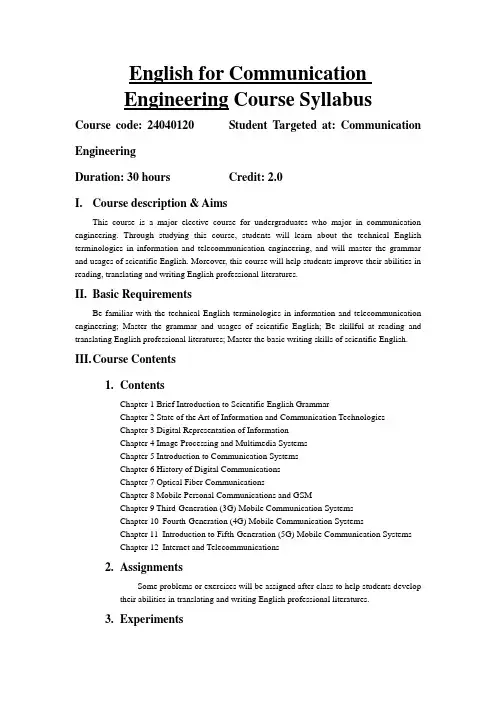
English for CommunicationEngineering Course SyllabusCourse code: 24040120 Student Targeted at: Communication EngineeringDuration: 30 hours Credit: 2.0I.Course description & AimsThis course is a major elective course for undergraduates who major in communication engineering. Through studying this course, students will learn about the technical English terminologies in information and telecommunication engineering, and will master the grammar and usages of scientific English. Moreover, this course will help students improve their abilities in reading, translating and writing English professional literatures.II.Basic RequirementsBe familiar with the technical English terminologies in information and telecommunication engineering; Master the grammar and usages of scientific English; Be skillful at reading and translating English professional literatures; Master the basic writing skills of scientific English.III.C ourse Contents1.ContentsChapter 1 Brief Introduction to Scientific English GrammarChapter 2 State of the Art of Information and Communication TechnologiesChapter 3 Digital Representation of InformationChapter 4 Image Processing and Multimedia SystemsChapter 5 Introduction to Communication SystemsChapter 6 History of Digital CommunicationsChapter 7 Optical Fiber CommunicationsChapter 8 Mobile Personal Communications and GSMChapter 9 Third-Generation (3G) Mobile Communication SystemsChapter 10 Fourth-Generation (4G) Mobile Communication SystemsChapter 11 Introduction to Fifth-Generation (5G) Mobile Communication SystemsChapter 12 Internet and Telecommunications2.AssignmentsSome problems or exercises will be assigned after class to help students develop their abilities in translating and writing English professional literatures.3.ExperimentsNot required4.PracticeNot requiredIV.Schedule1.Schedule2.Teaching methodThis course’s contents focus on both the fundamentals of information and communication engineering and emerging communication technologies. Therefore, thecourse materials should not be limited to the contents of textbook and just need tofollow the state-of-art of related technology fields.3.Course EvaluationAt the end of this course, students will be evaluated on their classroom participation, assignments, and the final examination. The formula is: Classparticipation (10%) + Assignments (10%) + Final test (80%) = Course result (100%). V.Textbooks & Reference Books1.Textbooks[1] Xiulan Xu, et al., English for Information and Communication Engineering, Post & Telecom Press, 2010.[2] Yilin Chang, et al., English for Communication Engineering, Xidian University Press, 2001.2.References[1] Jeffrey G. Andrews, et al., “What Will 5G Be?”, IEEE Journal on Selected Areas in Communications, vol. 32, no. 6, Jun., 2014, pp. 1065-1082.[2] Gerhard Fettweis, et al., “5G: Personal Mobile Internet beyond What Cellular Did to Telephony”, IEEE Communications Magazine, vol.52, no. 2, Feb., 2014, pp. 140-145.[3] Zukang Shen, et al., “Overview of 3GPP LTE-advanced carrier aggregation for 4G wireless communications”, IEEE Communications Magazine, vol.50, no. 2, Feb., 2012, pp. 122-130.[4] P. W. C. Chan, et al., “The evolution path of 4G networks: FDD or TDD?”, IEEE Communications Magazine, vol.44, no. 12, Dec., 2006, pp. 42-50.Prepared by:Liang ZhonghuaDepartment Chair:______School Dean:___________。


通信工程专业英语教程The field of communication engineering has experienced remarkable advancements in recent years, driven by the rapid technological progress and the ever-increasing demand for efficient and reliable communication systems. As the world becomes more interconnected, the role of communication engineers in shaping the future of global communication networks has become increasingly crucial. To meet the evolving needs of this dynamic industry, the development of a comprehensive and well-structured English curriculum for communication engineering majors is of paramount importance.The primary objective of an English curriculum for communication engineering students should be to equip them with the necessary language skills and technical knowledge to effectively navigate the global landscape of communication technologies. This curriculum should be designed to not only enhance their proficiency in English but also to provide them with a deep understanding of the specialized terminology, concepts, and methodologies relevant to their field of study.One of the core components of such a curriculum should be a strong emphasis on technical writing and communication. Communication engineers are often required to prepare technical reports, proposals, and presentations, which necessitate the ability to convey complex information in a clear, concise, and professional manner. The English curriculum should therefore include courses that focus on technical writing, report writing, and professional communication, providing students with the opportunity to develop these essential skills.In addition to technical writing, the curriculum should also incorporate language training that caters to the specific needs of communication engineers. This may include courses on academic English, scientific and engineering English, as well as English for specific purposes (ESP) courses that cover topics such as telecommunication systems, signal processing, and network protocols. By providing students with a solid foundation in the language used in their field, they will be better equipped to engage in discussions, read and comprehend technical literature, and collaborate with international colleagues.Another crucial aspect of the English curriculum for communication engineering majors should be the integration of project-based learning. This approach allows students to apply their language and technical skills in real-world scenarios, fostering their ability to work in teams, solve complex problems, and communicate effectively withdiverse stakeholders. Such projects may involve the design and implementation of communication systems, the analysis of network performance, or the development of innovative communication technologies.Furthermore, the curriculum should incorporate opportunities for students to engage in international collaborations and exchanges. This could include student exchange programs, virtual international team projects, or participation in global communication engineering conferences and workshops. These experiences not only enhance students' language proficiency but also expose them to different cultural perspectives and industry practices, preparing them for the global nature of the communication engineering field.To ensure the effectiveness of the English curriculum, it is essential to incorporate ongoing assessment and feedback mechanisms. This may include regular evaluations of students' language proficiency, technical knowledge, and communication skills, as well as feedback from industry partners and alumni to ensure the curriculum remains relevant and responsive to the evolving needs of the communication engineering sector.In conclusion, the development of a comprehensive English curriculum for communication engineering majors is a crucial step in preparing the next generation of communication professionals. Bycombining language instruction with technical knowledge and practical application, this curriculum will equip students with the necessary skills and competencies to thrive in the dynamic and globally interconnected world of communication engineering. As the demand for efficient and innovative communication systems continues to grow, the importance of a well-designed English curriculum cannot be overstated, as it will contribute to the development of highly skilled and globally-minded communication engineers who can drive the future of the industry.。
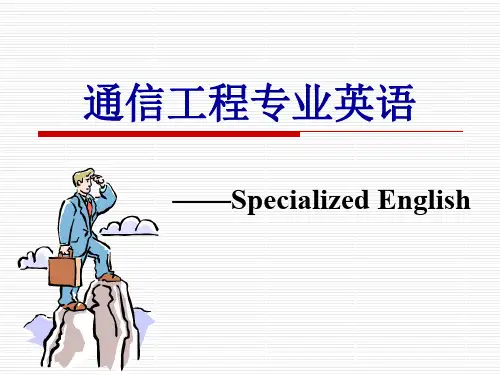
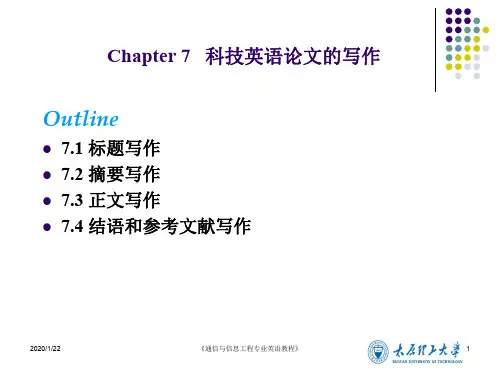
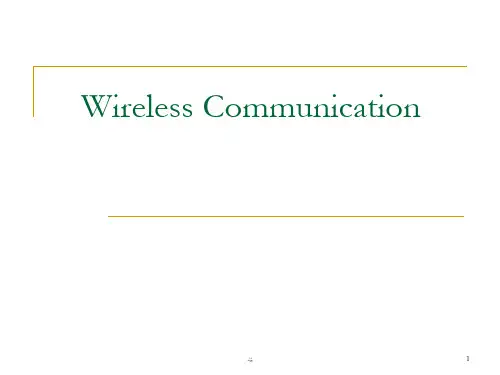
《通信工程专业英语》理论课教学大纲
一、课程基本信息
二、课程目标与任务
通过课堂讲授、课堂讨论、习题等环节教学。
实现下列教学目标:
(1)使学生获得专业英语词汇、阅读技巧、专业英语常见语法现象和表达方法、常见专业英语文体等方面的知识、理论与方法;
(2)使学生获得阅读和翻译专业英语文献的能力,以及撰写学术论文的技能;
(3)培养学生专业英语方面的综合素质。
三、课程主要内容、要求及学时分配
四、主要教学组织形式与方法手段
1.组织形式
主要采用班级授课的组织形式。
2.教学方法
主要采取讲授法、讨论法、练习法、任务驱动法、自主学习法五、课程考核和成绩评定。
信息与通信工程专业英语(第2版)韩定定李明明第一课现代数字设计及数字信号处理课文 A: 数字信号处理简介1.什么是数字信号处理?数字信号处理,或DSP,如其名称所示,是采用数字方式对信号进行处理。
在这种情况下一个信号可以代表各种不同的东西。
从历史的角度来讲,信号处理起源于电子工程,信号在这里意味着在电缆或电话线或者也有可能是在无线电波中传输的电子信号。
然而,更通用地说,一个信号是一个可代表任何东西--从股票价格到来自于远程传感卫星的数据的信息流。
术语“digital”来源于“digit”,意思是数字(代可以用你的手指计数),因此“digital”的字面意思是“数字的,用数字表示的”,其法语是“numerique”。
一个数字信号由一串数字流组成,通常(但并非一定)是二进制形式。
对数字信号的处理通过数字运算来完成。
数字信号处理是一个非常有用的技术,将会形成21世纪的新的科学技术。
数字信号处理已在通信、医学图像、雷达和声纳、高保真音乐产生、石油开采等很广泛的领域内引起了革命性的变革。
这些领域中的每一个都使得DSP 技术得到深入发展,有该领域自己的算法、数学基础,以及特殊的技术。
DSP发展的广度和深度的结合使得任何个人都不可能掌握已发展出的所有的DSP技术。
DSP教育包括两个任务:学习应用数字信号处理的通用原则及学习你所感兴趣的特定领域的数字信号处理技术。
2.模拟和数字信号在很多情况下,所感兴趣的信号的初始形式是模拟电压或电流,例如由麦克风或其它转换器产生的信号。
在有些情况下,例如从一个CD播放机的可读系统中输出的信号,信号本身就是数字的。
在应用DSP技术之前,一个模拟信号必须转换成数字信号。
例如,一个模拟电压信号,可被一个称为模数转换器或ADC的电路变换成数字信号。
该转换器产生一系列二进制数字作为数字输出,其值代表每个采样时刻的输入模数转换设备的电压值。
3.信号处理通常信号需要以各种方式处理。
例如,来自于传感器的信号可能被一些没用的电子“噪声”污染。
--------------------------------------14课-----------------------------------------------------------------------------1、configuration 配置Topologies拓扑结构2、multidrop 插头式ring or loop 环状或回路型the mesh 网状3、simultaneously 同时intelligence 情报4、perpheral equipment 外围终端5、essentially /in nature 本质上6、vary considerable 在很大程度上7、hotel reservation systems 宾馆预订系统8、telecommunications network 电信网络9、plural 复数mass media 大众媒体10、ATM = automatic teller machine11、simplex 单工,duplex 双工,HDX = half duplex, FDX= full duplex, F/FDX= full/full duplex12、unidirectional 单向的,two-way alternate or either-way lines 双向交替或任一方向电路13、citizens band 民用波段14、postal system 邮政系统15、indefinitely 不确定的16、vice verse 反之亦然17、error control 差错控制,error detection 检错,error correction 纠错,echoplex 回送18、Trade-off 平衡,折中考虑,serial-parallel transmission串行和并行传输19、between the source and destination 在源地和目的地之间20、short-distance communications 近距离通信21、and serial transmission is used for long-distance communications 远距离通信22、To insure an ordly flow of data between the line control unit and the modem,a serial interface is placed between them .23、in data communications,there are four types of synchronization(同步)that must be achieved:bit or clock synchronization,modem or carrier synchronization,character aynchronization,and message synchronization.1、Innovation 进步2、optical feeder links 光馈链接,digital compression techniques 数字压缩技术3、service integration 综合服务4、频分复用frequency-division multiplexing5、utilize 利用6、in this implementation 在这种实现方式中7、fiber-to-the-curb(FTTC) 光纤到路边8、视频点播video on demand(VOD)9、telephony 电话,industry 行业10、the CATV industry is deploying bidirectional networks —CATV 行业有必要拓展双向网络11、noted above 前面提到的12、atenuates 衰减13、nonadjacent 不毗连的,turn over 移交,subscribers 订户14、packet-switched wireless network 分组交换无线网络15、with the sponsorship 在---的资助下16、hub 中心17、on the order of 大约,在---数量级18、penetration 渗透无线局域网WLAN = wireless local area networktoehold 立足点notebook 笔记本backbone 骨干,integrated services 综合服务,multimedia Web access 多媒体网页访问公共信道信令common channel signaling电话用户subscriber telephone远程监控remote monitoring同步传输synchronous transmissionSDLC 同步数据链路控制=synchronous data link controlHDLC 高级数据链路控制=high-level data link control信息包packet自同步码self-aynchronizing code存储转发分组交换store-and-forward packet-switchingLAN 局域网= local area networkWAN 广域网= wide area network异步传输模式(ATM)= Asynchronous Transfer modecell 信元,feeder 馈电线有线电视CATV = community antenna television障碍物obstructionunidirectional 单向的nonadjacent 不相邻的,turn over 反复考虑with the sponsorship of 在----的资助下on the order of 与----相似的toehold 立足点,notebook 笔记本掌上电脑palm-sized computerbackbone 骨干,脊椎机顶盒set-top TV boxmultiplex 多路复用ISDN = integrated services digital network分组交换packet-switch数字用户线路DSL = digital subscriber linestore and forward 存储转发计算机串口the serial port of computer devices它是短距离(少于30米)的低速率(为38kbps)传输标准This standard is for low bit rate(up to 38kbps) transmission over short diatances(less than 30m)每次一个字符one character at a time可以添加一个奇偶校验比特用于检错they can add a parity bit for error detection连续字符successive characters时间间隔time interval当接收器检测到一个新字符的开始时When the receiver detects the beginning of a new character非双绞线untwisted wires随着速率和距离的增加as the rate and the distance increase----------------------------------------------17课-----------------------------------------------------1、simultaneously 同时的2、facsimile 传真3、audio 音频4、severe terrain 恶劣的地形5、composite 合成6、preemphasis network 预加重网络7、deviator 偏差器8、precede 在-----之前9、amplitude 丰富10、artificial boost 人为的提升11、IF = intermediate frequency12、Conventional 常见的13、Mixer 混频器14、Oscillator 振荡器15、Multiply 倍频16、Heterodyning 外差作用17、Crystal oscillator 晶体振荡器18、Factor 指数19、Noncoherent 非相关的20、Detector 检波器21、Amplitude-versus-frequency characteristics幅频特性22、载波比carrier-to-noise ratio23、信噪比signal-to-noise ratio24、Modulated 调制器25、Deemphasis network 去加重网络26、In digital microwave communications systems,phased shift keying is usually used tomodulate the HF carrier by baseband signal27、The receive module down-converts the Rf carrier to IF ,the IF AMP /AGC and equalizercircuits amplify and reshape the IF28、The received RF signal enters the receiver through the channel separation network andbandpass filter29、The term “digital radio”is used to refer to any microwave radio that transmits PCMcarrier signals ,regardless of how or at what point the signals are inserted into the radio equipment.30、The equalizer compensates for gain-versus-frequency nonlinearities and envelop delaydistortion introduced in the system.18课1、celestial body 天上的2、space vehicle 太空交通工具3、military 军事4、GPS = global positioning system 全球定位系统5、Navigation 航海,航行6、Incorporate 合并7、Frame 设计8、Sector 部门9、Aeronautical 航空10、Geostationary orbital 同步轨道11、Highly elliptical orbital 高椭圆轨道12、Sole 基础13、Briefcase 公文包14、Significantly 值得一提的是15、Alphanumeric pagers 文字数字寻呼机16、Exploits 发射17、Dual-mode phone 双模电话18、蜂窝网络cellular network19、Multi-spot-beam coverage 多点波束覆盖技术20、Inversely proportional to 反比于21、Collective 集中地22、Cruise liner 巡航船23、Aircraft 飞机24、Fixed 固定的25、同步卫星geostationary satellite26、赤道equator27、近赤道卫星equatorial orbit28、The satellite link is probably the most basic in microwave communications since aline-of-sight path typically exists between the earth and space .29、The ground segment consists of three main network elements :gateways,sometimescalled fixed earth stations ,the network control center and the satellite control center .Multiplexing of signals 信号复用Multiple-access system多址系统Allocated to 分配Simultaneously 同时Transponder 转发器Inherent 内在的Self-interference 自干扰Critical 更关键的Throughput 吞吐量Multi-spot-beam 多点波束Spot beam 波束Contemporary 当代的Pedestrian 步行者Hence因此Municipal agencies 市政部门By virtue of 利用Intriguing 巧妙地。